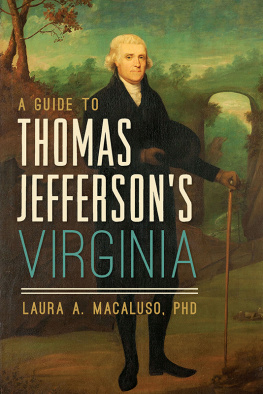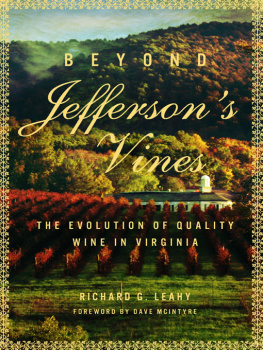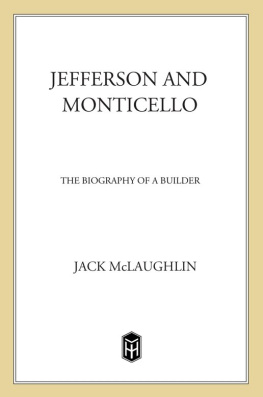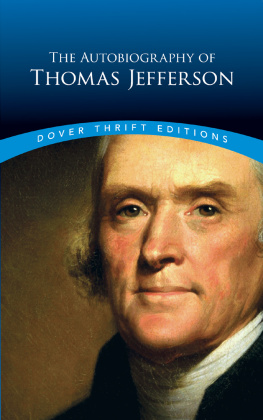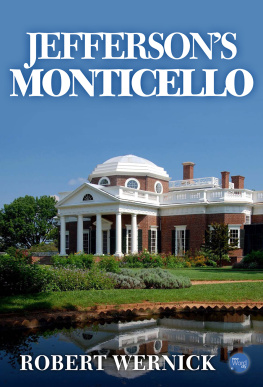


Suzanne Stryk, Looking Backwards, mixed media [USGS topographic map, clay, modeling paste, acrylic on Mylar, plants, measuring tape], 27 x 21 in., 2012. Stryk created this image with real clay from Thomas Jeffersons Poplar Forest during the production of her series of twenty-six assemblages titled Notes on the State of Virginia. Courtesy of the artist.


Published by The History Press
Charleston, SC
www.historypress.com
Copyright 2018 by Laura A. Macaluso
All rights reserved
Front cover image: Caleb Boyle, Thomas Jefferson at the Natural Bridge, oil on canvas, circa 1801. Lafayette College Art Collection.
First published 2018
e-book edition 2018
ISBN 978.1.43966.488.9
Library of Congress Control Number: 2018936064
print edition ISBN 978.1.46713.919.9
Notice: The information in this book is true and complete to the best of our knowledge. It is offered without guarantee on the part of the author or The History Press. The author and The History Press disclaim all liability in connection with the use of this book.
All rights reserved. No part of this book may be reproduced or transmitted in any form whatsoever without prior written permission from the publisher except in the case of brief quotations embodied in critical articles and reviews.
Charlottesville, Virginia,
August 1112, 2017
This is the last stopits not so black and white.
David J. Matthews and Stefan Lessard, The Last Stop (1998)
A Concert for Charlottesville, September 24, 2017
CONTENTS

Readers are encouraged to contact each organization before visiting to confirm hours of operation and tour schedules, as well as to learn about special programming and unexpected closings.
FOREWORD
It is one thing to read about Thomas Jefferson, either in his own words or in the history and opinions written by others, but it is an entirely different and far more vivid experience to actually see Mr. Jefferson by visiting the scenes and places where he was present. Laura Macalusos welcomed addition to the already vast bibliography of books about Thomas Jefferson allows one to actually seek out and discover the settings and buildings in which the presence of the man may still be felt.
Herein, Ms. Macalusos work provides us with a virtual itinerary of places to visit where we may envision Thomas Jefferson in his day-to-day world, from his early childhood through the last years of his life. Her chapters present the places that are both well known and out of the way. Different from many other works on the life of Mr. Jefferson, we become the master within these pages to map our own course in pursuit of a more intimate association with Jefferson and his beloved Virginia. For the first time, many places merely referred to in other books are now more fully revealed both in print and picture, encouraging us to visit these little-known sites connected with Jeffersons life. In so doing, we uncover the veil of the passing of time to see that a majority of sites and locations, with their ageless ambiance, remain unchanged. In these pages, we gain a better sense of place in Jeffersons world; we can grasp more readily his lifelong quest to establish a universal suffrage through educated citizenship.
From his childhood years at Shadwell Farm and Tuckahoe Plantation, through to his adolescence and young adulthood in Williamsburg, Virginia, Ms. Macaluso takes us to the integral sites of Jeffersons first cognizances and years of early enlightenment, and we enter into the buildings he knew and inhabited. We visit with his friends James Madison, James Monroe, James Barbour and others at their own homes. We become familiar, as he was, with the finest libraries in Virginia and are able to gain a better understanding of the sources for his only published narrative, Notes on the State of Virginia. Accordingly, Ms. Macaluso provides us with the information to visit the settlements, cities, towns, mountains and rivers, along with the resources for references within Jeffersons Notes, to become familiar with the flora and fauna of Virginia and the diversity of population within the former colony and young Commonwealth of Virginia.
Best of all, we are able to have an in-depth visit at Poplar Forest, Mr. Jeffersons Retreat House, where he went to escape the onslaught of curiosity seekers who besieged him at Monticello. It was at Poplar Forest that Jefferson could feel the most intimate and secure with family and friends, a place where he said, I may go to read, to write, but most importantly, a place where I may think. Imagine the need in Mr. Jeffersons mind to get away in the four-mile-per-hour world in which he lived, simply to be able to think more profoundly. At Poplar Forest, we are able to see that more private Mr. Jefferson. We are better able to acquaint ourselves with the man as a private citizen and his innate love of agriculture, husbandry and his lifelong pursuit of maintaining good health.
This work is complete with directions and information on the final resting places of Thomas Jefferson and his friends. This supports the sentiments of Jefferson, the man, in his wishes to be buried among his native woods and fields, for nowhere else could take its place. Laura Macalusos book helps us to take our place in Thomas Jeffersons Virginia. It prepares us well and supports our journey into the private world of a man who was a living legend in his own times. For those who have yet to be introduced to Thomas Jefferson, may this book prove a happy meeting. For those already grounded in Jefferson studies, may this be a delightful refresher and open new doors for a more intimate relationship with the man and the myth.
BILL BARKER
PREFACE
There is a place called Jefferson Country. I first learned of it when my husband accepted a position working for Thomas Jeffersons Poplar Forest in 2012. As Connecticut Yankees, we were unexpectedly part of a network of places associated with this iconic man and his life and legacy in the Piedmont region of central Virginia. As it turns out, Jefferson Country is both a geographic locale and a sensibility about what it means to be a Virginianand an American. Thomas Jefferson himself is behind this approach to living and appears in all sorts of circumstances, from historic sites to the names of plazasand even to the name of a burger on the menu of a local restaurant. There are bronze monuments, historic markers and paintings of him everywhere, not to mention numerous historic sites and landscapes associated with him, many of which are the subject of this book. His memory and presence is curated and cultivated in central Virginia and represents an idealized version of living via the Enlightenment, with an emphasis on education, reasoned thinking and an appreciation for nature.
Jefferson Country is not without its problems, however. Within the picture of refined red brick buildings with creamy white classical columns and against the verdant rolling landscape and the Blue Ridge Mountains, there are generations of people for whom the phrase Jefferson Country meant only enslavement and, later, a life constrained by post-Reconstruction practices that pulled back on new freedoms for African Americans and created a segregated society that lasted another one hundred years, the effects of which everyone struggles with today.
Next page
